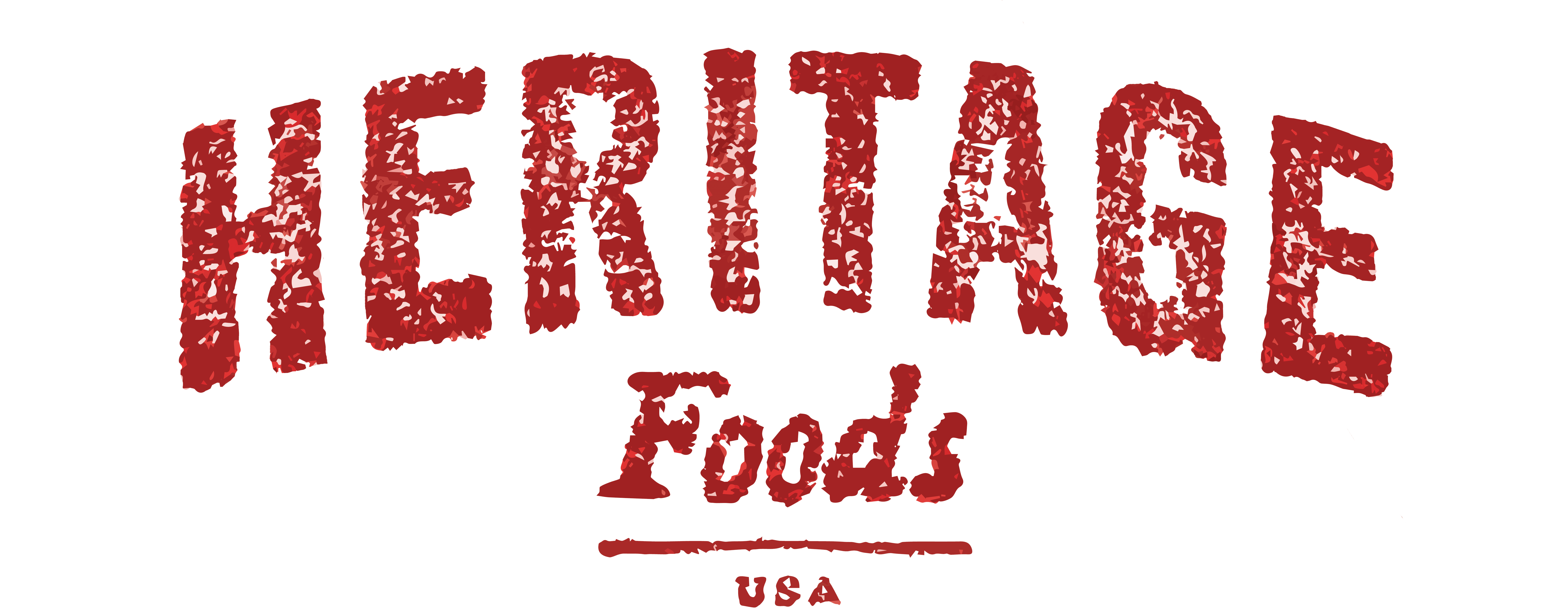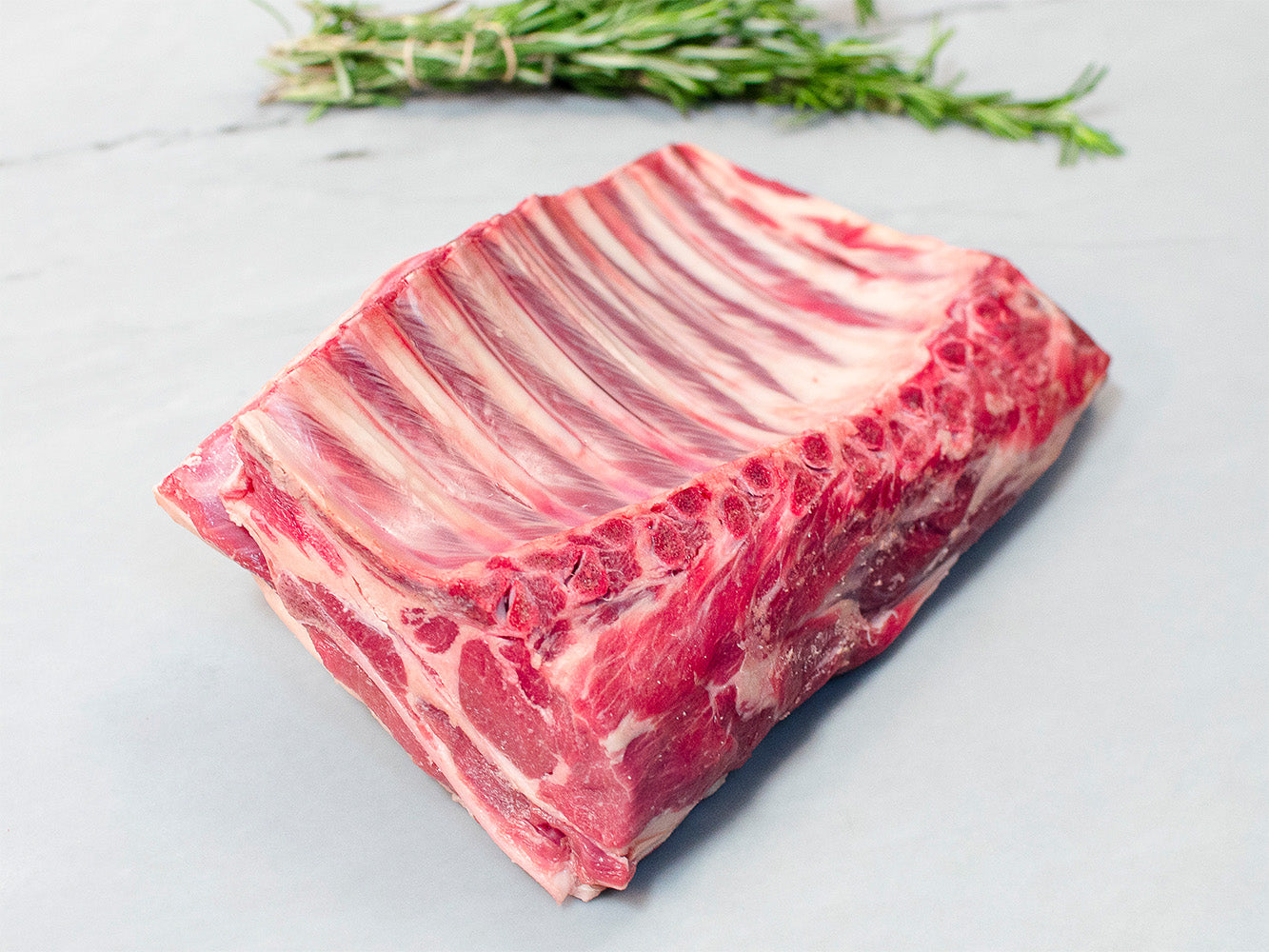
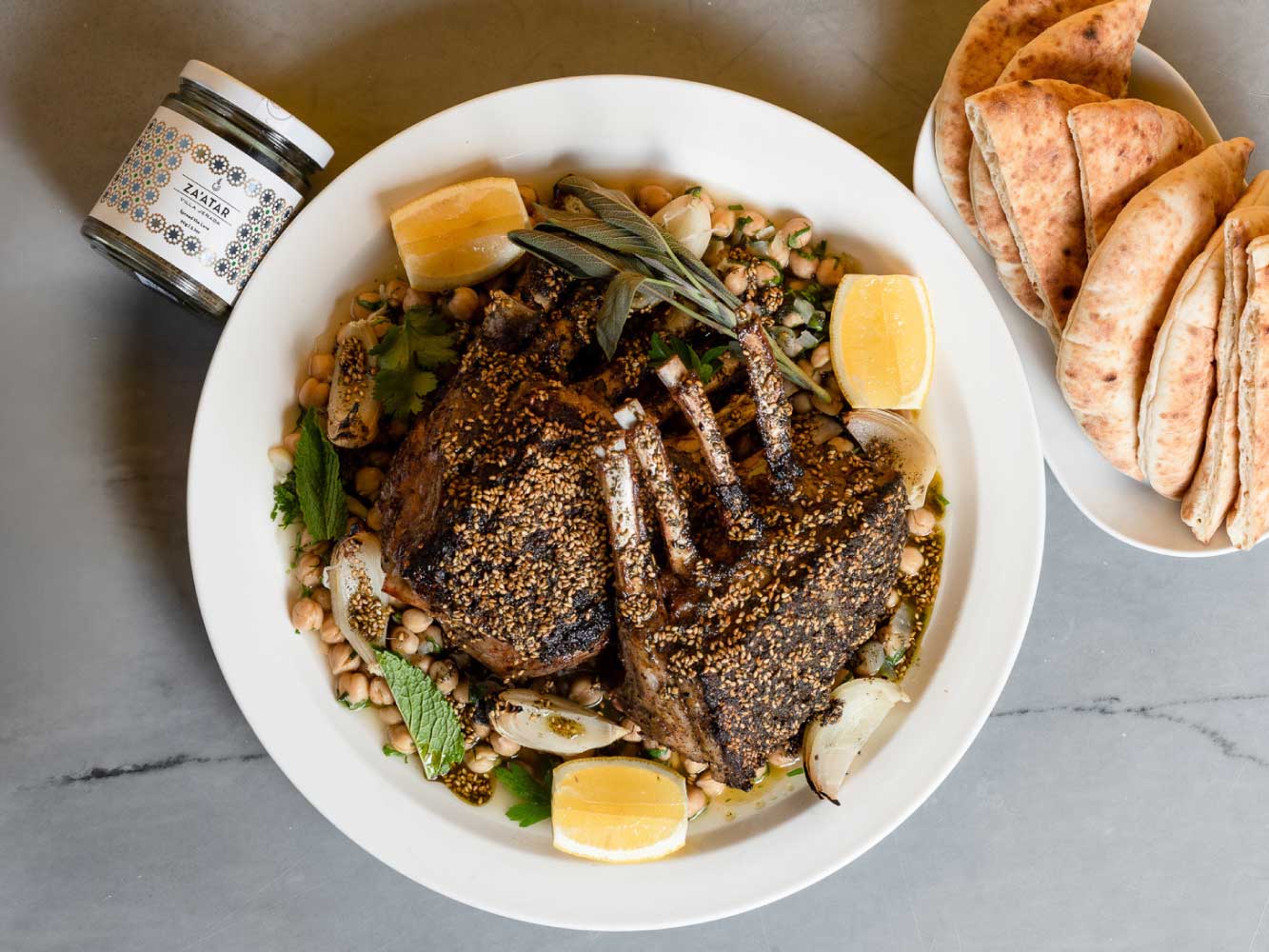
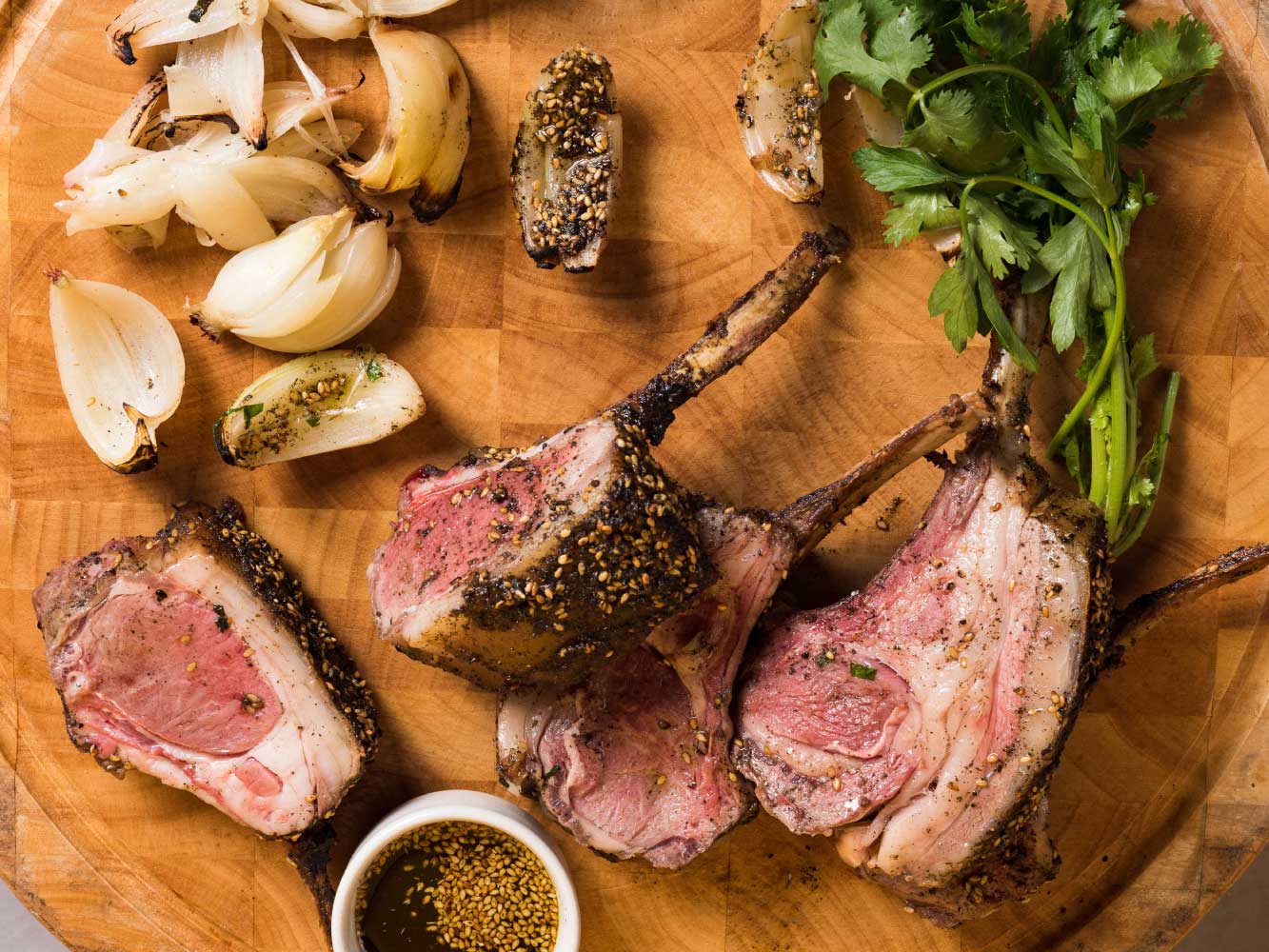
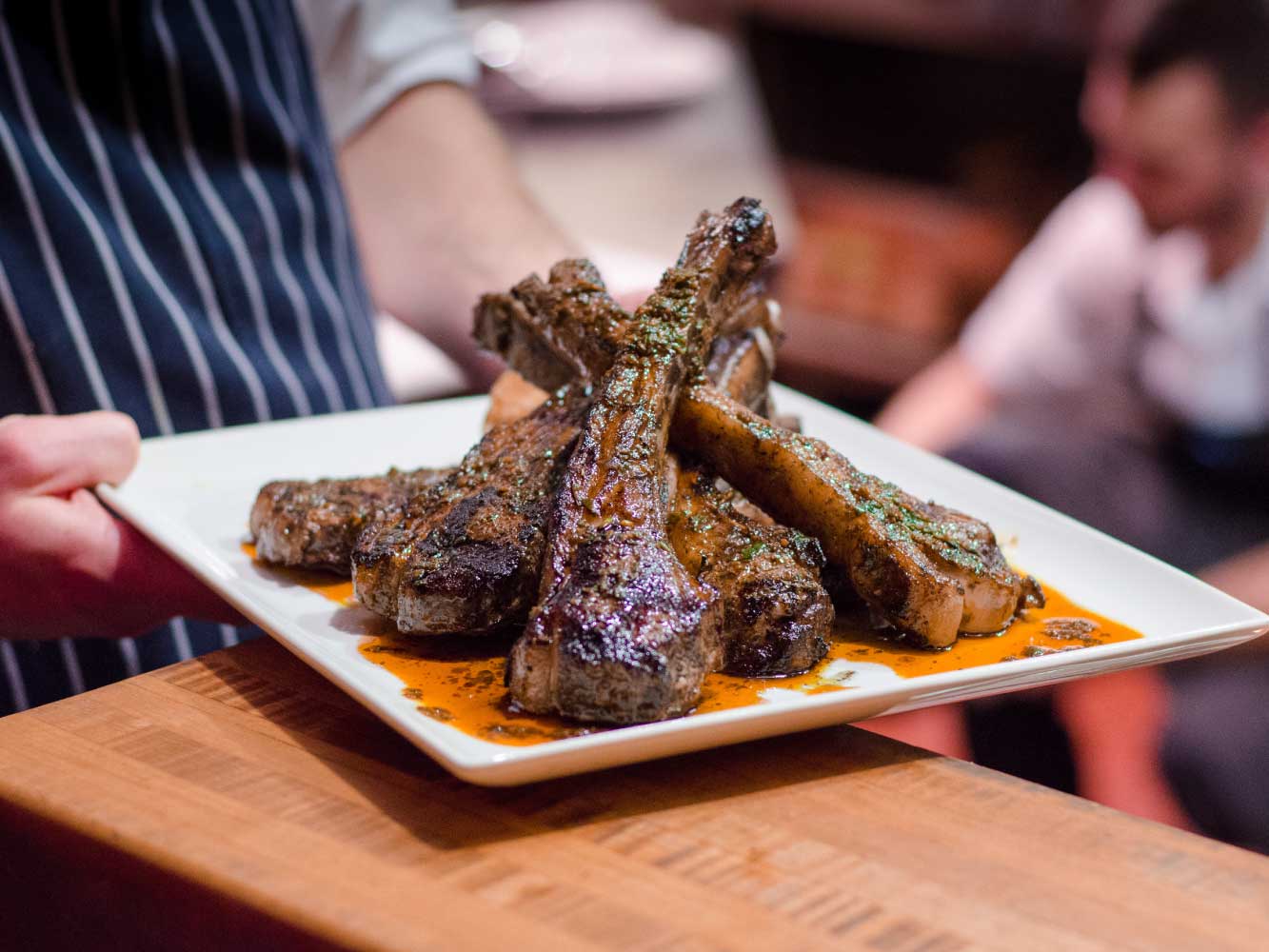


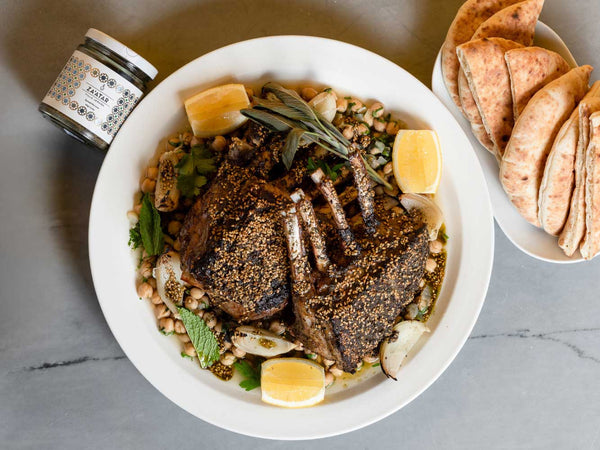
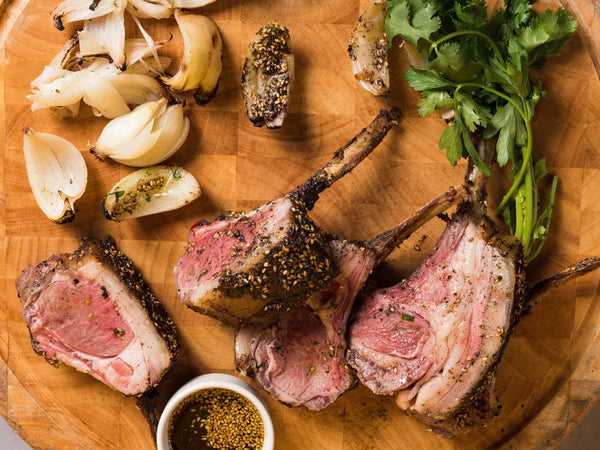
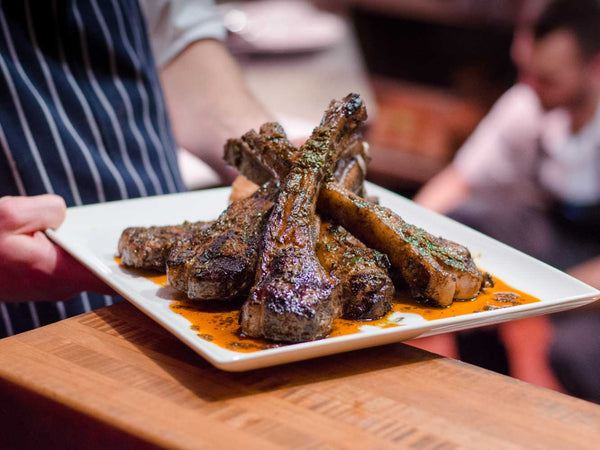






Bone-in — From America's oldest and rarest breeds — Tunis or Dorset Horn
Rack of Lamb
Tunis or Dorset Horn
Choose your preferred size from the drop down menu above.
The rack of lamb is often considered the most elegant cut, ideal as the centerpiece for an intimate dinner party worthy of royalty, or simply a special family dinner. Roast it whole for a show-stopping presentation, or slice between the bones to plate the tasty chops individually. Simple to prepare — as with all of our healthy and delicious Heritage lamb, we love just salt, pepper, and a little bit of rosemary.
Our lamb is sourced from our long time farm partners in Vermont, Tamarack Sheep Farm, where three rare breeds of lamb are raised on pasture — breeds that have been raised there since the 1920s. Lamb is a seasonal livestock that is available four or five times a year.
Ben Machin and Grace Bowmer raise three breeds of heritage breed sheep on their beautiful Tamarack Sheep Farm located on the rolling hills and green pastures of Vermont.
As Ben explains, “Grass, it is at the heart of our operation, and restoring grassland and soil is one of the reasons that we scaled up our operation.” All of the animals on Tamarack Farm have access to grass 100% of the time. In the summer, this means grass growing in the field, in the winter, or for animals that are housed in the barn, this means hay.
Ben and Grace make all their own hay, managing about 120 acres of hay land. They have four old John Deere tractors, and all the equipment to make round bales. They fertilize the fields and cut them three or four times each year to keep the quality high. Supplements for the lamb include whole grains as opposed to ground or pellet feed.
Most of the more successful commercial breeds of lamb are a mix of quite a few other breeds — hybrid vigor is a really big deal in the industry. But Ben and Grace are 100% committed to heritage breeds, both because they have a family tradition that’s almost 100 years old, and because they feel that the genetics are potentially quite important to the future.
The fastest growing sheep breed worldwide is the hybrid White Dorper and it would not exist if not for the foundational Horned Dorset genetics that were used to create it, the kind currently grown on Tamarack Farm. Dorpers are proving essential to allowing sheep farmers to adapt to climate change in various parts of the world, and it’s the heritage breed in them that allows them to be so resistant and strong. Ben and Grace have participated in a program with the Swiss Village Foundation and the Smithsonian, who collected eggs and semen from 80 of their animals over a 10-year period to store in cryogenic freezers.
There are incredible challenges to raising heritage breed animals. Heritage breeds are inherently less productive, in general, than the modern breeds. But for Ben and Grace it’s worth it: Ben’s great-grandfather started a Tunis flock in the 1920s. Years later, Ben's grandfather, Herb, began to work with Dorset Horn sheep for a 4-H project. In 2006, in Herb’s last days, Ben made the monumental and wonderful decision to dedicate himself to revitalizing the family flock. Grace joined Ben in 2008. Grace came with a background in architecture, site design, landscaping, and gardening, and together they purchased the land and built a barn.
Today with a fifth generation in the mix, there is even more reason to continue their efforts on the farm despite new challenges. Many of their local restaurant customers have taken a beating with recent global events, but sunny days on grassy pastures look to be in the future, which is good news for chefs and lovers of lamb! Ben and Grace have increased production on Hogget (1-2 year old sheep) and mutton (2+ year old sheep) on their farm because of increased demand.
According to Ben, the Tunis breed is lean but has the richest taste of all. He remembers the Navajo Churro as being a bit drier but still delicious and succulent. The Dorset Horn is very moist and mild flavored. Ben especially loves the Horned Dorset, “because both males and females grow horns!” Amazingly the taste and flavor of all three breeds becomes more subtle and mild as the animal ages on the hoof.
The Tunis is earthy with notes of buttermilk. The Dorset is lighter, with a clean, floral finish. The Navajo-Churro lamb is remarkably tender — even the braising cuts can be grilled.
Tunis, Dorset Horn, and Navajo-Churro Breeds of Lamb
Tunis: Originally from Tunisia, the breed was brought to the U.S. as a gift to George Washington and raised by the first three Presidents. This is the same lamb as was written about in the Bible, but the modern version has a less fatty tail.
Dorset Horn: A breed of sheep that spread over Dorset, Somerset, Devon, and most of Wales, in the 1750s this is the breed the English with a fine palate would eat for Christmas! Very few farmers still raise this endangered breed.
Navajo-Churro: The first domesticated livestock to ever come onto American soil, the Churro breed was brought here by early Spanish explorers and quickly adopted into the culture of the Navajo Nation in the Southwest. The breed was used for wool and meat but today is considered America’s rarest breed of lamb.
How to Prepare
1. Take the roast out of the refrigerator an hour prior to cooking.
2. Preheat your oven to 450℉.
3. Season liberally with salt and pepper on all sides.
4. Sear on all sides in a hot pan until browned.
5. Move to a roasting pan lined with a rack and cook at 450℉ for 15-20 mins for an even crust.
6. Lower the oven temperature to 300℉ and cook for 30 minutes checking the meat every 15 minutes thereafter until the roast reaches your desired internal temperature (130℉ approximately for lamb to medium rare.) The internal temperature will continue to rise slightly after leaving the oven. Let rest for 10-15 minutes before carving.
See recipe below for Roasted Lamb Rack with Lamb Fat Roasted Carrots, Carrot Puree, and Cracklings
———————
Roasted Lamb Rack with Lamb Fat Roasted Carrots, Carrot Puree, and Cracklings
ingredients:
1 heritage lamb rack
2lb baby rainbow carrots
¼ bunch of parsley (finely chopped)
1 lemon
2 tablespoons Lambrusco vinegar
2 tablespoons toasted cumin seeds
1 head of garlic (crushed cloves)
2-3 sprigs of thyme
1 tablespoon butter
1 tsp chili flakes
Salt and pepper
Trim the fat cap off the rack of lamb 3-4 inches from the top of the bone until right above where the eye of the rack begins. Trim and remove all the fat between the individual bones and scrape well with a paring knife. Set all the lamb fat aside. You may further clean the bones for an impressive display by rubbing the remaining bits of fat and meat off the bones with a clean kitchen towel.
Where the eye of the rack begins (below where you trimmed), lightly score the remaining fat cap in a cross-hatch pattern. Be careful not to pierce the meat. Place on a roasting pan with a wire rack. This can be done the day ahead and you can leave the rack of lamb uncovered in the fridge to dry out a little more. Make sure you remove the rack from the fridge at least an hour before you cook it to bring it closer to room temp for roasting.
Rendering Your Lamb Fat and Making Cracklings:
Rendering fat from any animal will follow this similar process, it will provide a nutritious and flavorful fat that you can use anywhere you would use lard or butter or oil.
Preheat the oven to 220℉ or set up a slow cooker on low. Dice the reserved fat cap into 1-inch cubes, add to a small dutch oven or pot with lid, and add 2 cups of water. Place in your oven for 4-6 hours or closer to 7-8 for a slow cooker. The ideal rendering temperature is at or just above the boiling point of water 212℉ so check it every 20-30 minutes as you don’t want it to brown. Once most of the fat has rendered and the water has boiled off your remaining rendered lamb fat will be relatively clear. Pull it off the heat and let cool for a half hour before straining through a fine mesh strainer. Save the remaining bits of fat to make cracklings.
Spread the remaining fat bits out on a 10-inch skillet and roast in an oven at 300℉ for about an hour until crispy, strain out the additional rendered fat and place on a baking sheet lined with paper towels to remove the excess fat. Season with salt.
Roast Your Carrots:
Wash and trim the greens off your baby carrots. Toss in a bowl with salt, pepper, 2 tablespoons of render lamb fat, toasted cumin seeds, cloves of garlic, chili flakes, and thyme, and place on a baking sheet and roast at 425℉ until tender, about 30 minutes.
Roast your Lamb:
Preheat your oven to 450℉. Season liberally with salt and pepper on all sides. Sear on all sides in a hot pan until browned.
Move to a roasting pan lined with a rack. Add a small piece of foil to wrap around each individual bone and cook at 450℉ for 15-20 minutes for an even crust.
Lower the oven temperature to 300℉ and cook for 30 minutes checking the meat every 15 minutes thereafter until the roast reaches your desired internal temperature (130℉ approximately for lamb to medium rare.) The internal temperature will continue to rise slightly after leaving the oven. Let rest for 10-15 minutes before carving.
Make your puree:
In a blender add half your carrots and roasted cloves of garlic to the blender. Add 2 teaspoons Lambrusco vinegar, 1 tablespoon of lamb fat, and 1 tablespoon unsalted butter. Puree until smooth, adding water if too thick and seasoning with salt to taste.
Serving:
Remove the foil and carve the rack into individual chops. Spoon the puree on the bottom of a large platter. Top with the whole roasted carrots. Place the chops on top and garnish with your crispy cracklings, finely chopped parsley, and a squeeze of fresh lemon juice. Enjoy!
© 2025, Heritage Foods Powered by Shopify
